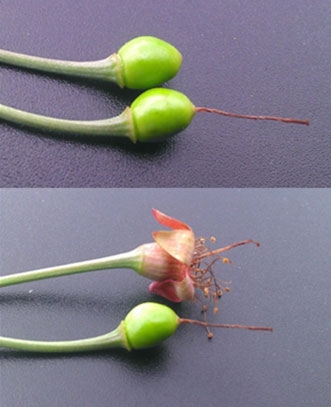Substantial advances have been made in understanding the underlying mechanisms involved in fruit cracking in recent years.
Management strategies to lessen the impact of rainfall late in the growing season have been developed and validated.
However, there is little known about the cracks associated with scar tissue at the apical-end of the cherry fruit, and indeed few studies have investigated the formation of that scar tissue.
This was the reasoning behind a component of project CY12000—can the incidence of scar tissue be reduced, and if so will it reduce nose cracking?
Observations in orchards around Australia and internationally have highlighted the prevalence of scar formation in production regions that experience cooler spring weather.
Spring temperature is known to significantly impact on a number of fruit developmental stages including flowering, pollination and fruit set. Slower fruit development means later shedding of floral parts, such as the style at the apical-end of the fruit (Figure 1) and this could be related to apical-scar development.
Formation of scar tissue has the potential to present a problem as fruit matures and when rainfall occurs.
This study provides some preliminary investigations of promoting faster development of fruit early in the season with the use of the plant growth regulator Cytolin.
Cytolin is not registered for use on cherry crops, but has been used to promote development and elongation of apple fruit.
Recently Cytolin has also been linked to reduced scar tissue in apples! In other studies it has been shown to induce cell division, cell elongation, fruit size and fruit setting. However, when applied at a high rate, fruit thinning has resulted.
Cherry trials
Six trials all using Lapins were conducted over the three years of this project. Lapins is prone to apical-end scarring and cracking.
A split application of Cytolin: at 50% bloom; full bloom (FB); and two weeks after full bloom (waFB) was made in each trial, and fruit compared to fruit from trees without Cytolin.
Without Cytolin floral parts were retained for longer in three trials and the time taken to reach 100% shuck fall was extended. At three weeks after full bloom small increases were seen in fruit length with Cytolin (8.2mm compared to 7.6mm) in one trial only.
Style retention was prolonged without Cytolin application in four of the six trials (Figure 2). In the other two trials there was no style retention with, or without Cytolin.
Cytolin applications had negligible effects on the fruit quality parameters: brix, firmness and acidity. However, in trials 1, 2 and 3 there was a small but significant increase in size (Table 1). A non-significant increase was seen in trial 4.
The fruit from trial 5 and 6 were harvested before full maturity due to significant rainfall events (100+ mm).
In one trial we examined the cuticle microscopically and found that it was thicker with Cytolin application, but there was no difference in actual scar size.
Conclusion
The application of Cytolin reduced the level of both apical end-scarring, and apical-end cracking in the four trials that had rainfall, and reduced subsequent cracking.
In control trees a greater proportion of scarred fruit went on to develop apical-end cracks (Figure 3).
Results show that there is potential to reduce apical-end scarring—and the associated cracking—by encouraging shedding of floral structures from the developing fruit in cooler regions.
To see this article and for contact information, see Tree Fruit Oct 2015




















